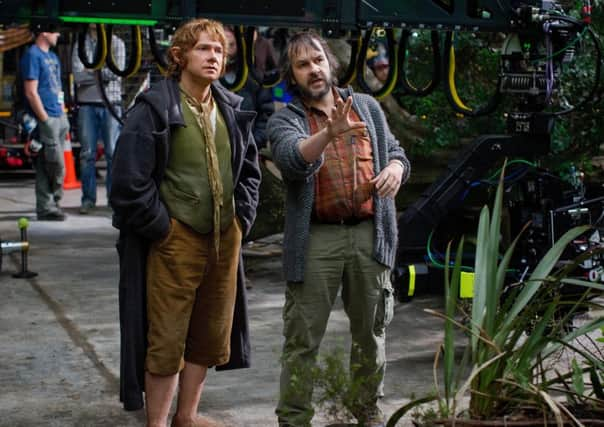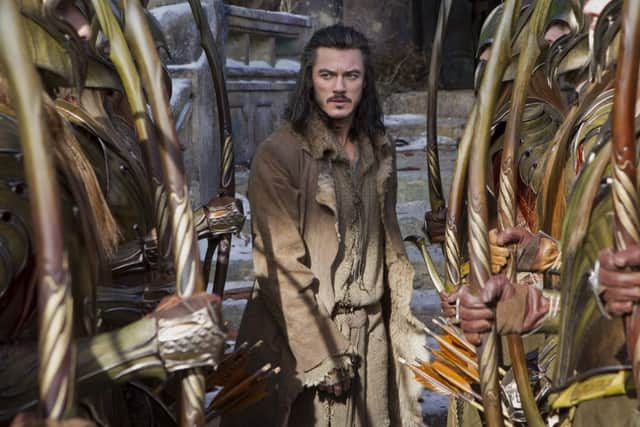Peter Jackson on bringing LOTR, The Hobbit to life


Every time Peter Jackson begins filming a new movie, he’s plagued by a recurring nightmare. He’s lying in bed surrounded by a film crew awaiting his direction, only he can’t quite remember what he’s supposed to be making, doesn’t know what’s in the script and can barely think straight. This same dream begins on every project after the first day of shooting and it lasts until the final day of filming. “And then it stops,” says Jackson. “Then I have nice dreams.”
Holding court in a London hotel room the day after the world premiere of The Hobbit: The Battle of the Five Armies, Jackson is presumably having nice dreams again now. His cinematic trisection of JRR Tolkien’s 1937 fantasy novel is finally over, and so too is the sojourn to Middle-earth the New Zealander undertook 17 years ago when he first pitched The Lord of the Rings trilogy and The Hobbit to Hollywood. Rejections, delays, complicated deals and legal wrangles followed, but given the immense scale of the back-to-back productions required to bring both sagas to the big screen, it’s hardly surprising that an anxiety dream for Jackson should involve the director not knowing what he’s doing.
Advertisement
Hide AdThis seems particularly apropos for The Hobbit. When he first called action on set four years ago, not only was he staring down the prospect of a 266-day shooting schedule – that’s a lot of nightmares – he didn’t yet know that the two movies he’d planned to make out of Tolkien’s comparatively short children’s book (a plan based on original director Guillermo Del Toro’s script for the project) would turn into another trilogy.


Fate has been steering him ever since
Having finished the lot, however, he’s come to the conclusion that fate has been steering him ever since he and partner Fran Walsh put in a provisional call to Harvey Weinstein about making the films back in 1997.
“We phoned Harvey, who we had a first-look deal with, and said, ‘If you can get us the rights to these books we’d like to make The Hobbit as one film and, if it’s successful, we’d like to do The Lord of the Rings as two movies’. Now, 17 years later, it has become six movies and we did them the wrong way round: we did Lord of the Rings first and The Hobbit was supposed to be two films, so it’s all been very weird. It’s not anything I could control – it’s just circumstance and fate – but the one thing I think I’m very proud of is that when people do see the six films in the series in the right order, then they’ll sort of sense there was some vague design behind it all, as chaotic as it actually was in terms of the order being changed around.”
Though Jackson hasn’t yet had time to watch all six films back-to-back (“24 hours of joy,” he quips), co-writer and fellow producer Phillipa Boyens reckons they lucked out making The Lord of the Rings first. “If we’d started with The Hobbit it would probably have been more of a children’s film, which wouldn’t necessarily have been a bad thing,” she says, but what she loves about they way they’ve ended up doing the series is that the expanded scope of The Hobbit films has given them the opportunity to deepen the relationships between characters like Gandalf (Sir Ian McKellen) and Galadriel (Cate Blanchette). “I love the fact that there’s a scene [in Battle of the Five Armies] where she comes to save him,” she elaborates. “So now, when she’s told in The Lord of the Rings that he has died, that’s going to play in a completely different way for people who watch it in that order.”
“The full arc of the story”
“And we’re only three or four years away from having the first generation of audiences who will watch these films in this order,” says Jackson. “When we started on The Hobbit we were definitely thinking of the full arc of the story.”
Realising this particular dream for the series has required an incredible amount of patience on Jackson’s part – and that’s a virtue the cast of The Hobbit trilogy has had to learn too. As Bard, one of The Hobbit’s few human heroes, Luke Evans remembers his first day on set four years ago involved shooting the spectacular rooftop battle with Smaug that now opens The Battle of the Five Armies. “I’ve waited a long time to see that,” he grins. Similarly, Martin Freeman found that having three movies in which to explore Bilbo’s transformation from the somewhat passive whinger of An Unexpected Journey to the much more complex and heroic hobbit he ends up becoming in The Battle of the Five Armies involved a lot of biding his time as an actor. “I was always trying to say to Peter, ‘When do I get to be angry? When do I get to show a different side?’ And he’d always be saying, ‘It’s coming, it’s coming. Don’t worry. Pace yourself.’ So you learn patience with regards to the different sides of the character that you’re going to get to show. You realise it will come. You just have to wait.”
Advertisement
Hide AdWaiting for something to happen was one of the chief criticisms of the first Hobbit film (particularly the notoriously dull domestic scenes featuring the dwarves doing dishes). That’s not a charge that can be made against the final instalment, which begins with the aforementioned battle with Smaug, follows through with dwarf king Thorin (Richard Armitage) going mad as he reclaims Erebor, and concludes with the titular showdown – a Battle of Helm’s Deep-style onslaught of elves, dwarves, orcs, humans and goblins that provides further connective tissue to The Lord of the Rings and allows Jackson to push the visual envelope further.
The latter aspect has become a hallmark of this entire saga. Jackson is quick to point out, though, that all the technological innovations were dictated by the demands of the story. “It’s not a chicken or egg thing,” he insists. “Once we knew we were doing the Tolkien movies we knew we were going to do battle scenes, so we knew we were going to have to write software that would allow us to create creatures and characters. If 17 years ago instead of pursuing Lord of the Rings I’d decided to do a little drama set in a fish-and-chip shop, then we wouldn’t have developed performance capture. I mean, I can barely work email. I’m an idiot with computers, unfortunately.”
Real legacy of The Lord of the Rings and The Hobbit films
Advertisement
Hide AdSo what does he hope the real legacy of The Lord of the Rings and The Hobbit films will be now that he’s finished with Tolkien for good? (The rights have never been made available for any of Tolkien’s other work.) “I just hope it will inspire people to make films,” surmises Jackson. “Films affect people in other ways too, but I’m sitting here today as a result of TV and films I saw as a kid: Thunderbirds, King Kong, Ray Harryhausen’s movies – they’re the reason why I’m here. They inspired me to become obsessive about making films, so it would be a wonderful thing if there were young kids today getting affected by these movies in the same way.” Now that sounds like a nice dream.
• The Hobbit: The Battle of the Five Armies is on general release